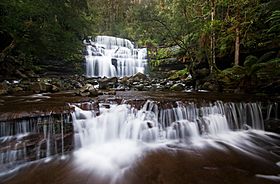Liffey River (Tasmania) facts for kids
Quick facts for kids Liffey |
|
|---|---|

Liffey Falls in the upper river
|
|
| Country | Australia |
| State | Tasmania |
| Physical characteristics | |
| Main source | Great Western Tiers Dry Bluff 1,210 m (3,970 ft) |
| River mouth | Meander River near Carrick 134 m (440 ft) 41°30′S 147°02′E / 41.500°S 147.033°E |
| Length | 52.6 km (32.7 mi) |
| Basin features | |
| River system | Tamar River system |
| Basin size | 224 km2 (86 sq mi) |
| Nature reserve | Liffey Valley Reserve |
The Liffey River is a river found in Northern Tasmania, Australia. It is an important waterway in the region.
Contents
River Journey and Surroundings
The Liffey River starts its journey at Projection Bluff. This is on the north side of Dry's Bluff in the Great Western Tiers mountains. It flows until it joins the Meander River near a town called Carrick. The Liffey is one of the main rivers that feed into the Meander River.
The area where the Liffey River collects its water is called its catchment area. This area is about 224 square kilometres (86 sq mi) wide. People have changed this area over time, mainly by diverting water for irrigation. This means water is moved to help grow crops.
The amount of water flowing in the river changes a lot with the seasons. The most water flows from July to September. Sometimes, extra water from the Cressy-Longford irrigation system is added to the river. This helps keep the river flowing in summer. This extra water comes from the Poatina Hydroelectric Power Station.
The upper parts of the river are known for their cool temperate rainforests. But most of the land along the river is used for farming.
Water Quality and History
The water quality in the lower parts of the river can be affected by farm runoff. This is water that flows off farms and can carry things like fertilizers. Also, a small amount of treated wastewater from a sewerage plant near Carrick goes into a small stream that flows into the Liffey. This plant also handles wastewater from nearby Hadspen.
The original people of this area, the Panninher clan, called the river Tellerpangger. When the British arrived, they renamed it Penny Royal Creek. This was because a plant called pennyroyal grew a lot along its banks. The Panninher people then became known as the Pennyroyal Creek Tribe.
Later, in the early 1800s, a settler named William Bryan helped change the river's name. He named it Liffey River after the River Liffey in his home country, Ireland.
Bridges Over the Liffey
The Liffey River, when it was still called Pennyroyal Creek, got its first bridge in Carrick in 1828. It was a simple bridge made of logs. In the 1830s, a stronger wooden bridge was built.
This Liffey bridge was fixed and made taller in the mid-1860s. But in May 1875, strong water washed away its foundations, and the bridge fell down. All the bridges over the Liffey, and the roads connected to them, would get covered when the river flooded. The big 1929 Tasmanian Floods even washed the bridge away completely.
In the 1950s, the road was rebuilt, and the bridge was replaced again. To stop floods from causing so much damage, both the road and the bridge were built much higher. This made the ground floor of the nearby Carrick Mill look very low compared to the new road.
Animals and Plants of the Liffey
The areas around the upper Liffey River are home to cool temperate rainforests.
Fish and Other Wildlife
People often fish for brown trout (Salmo trutta) in the Liffey River. The fishing season usually runs from August to April. Brown trout were first brought to the river in 1870. More trout were released in 1940. By 1949, some very large trout, weighing up to 11 pounds (5 kg), were caught in the upper parts of the river.
Besides the brown trout, the Liffey River is also home to platypus (Ornithorhynchus anatinus). Platypus in the Liffey River, like those in other nearby rivers, have sometimes been found with a fungal infection called Mucor amphiborum. This infection can make them very sick.


